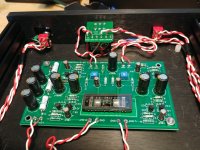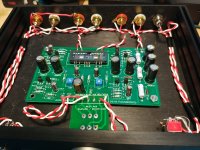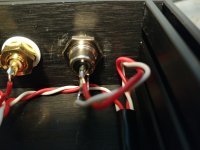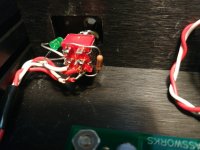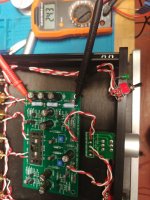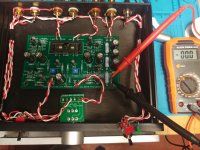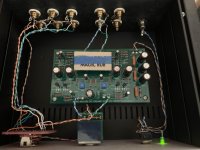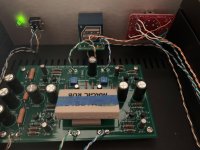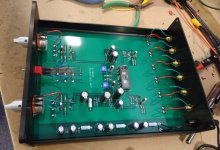Hikari1 Said:
"Muses probably don’t care about the quality of the supply I would imagine."
You've got me curious. Is your Post a comment on the quality of the Muses products?
Not at all. Muses stuff is supposed to be great. Pass labs uses it. What I mean is the power supply for a muses chip is used for logic and switching. Not amplification. A muse chip doesn’t even contain a buffer. Power supply quality will not effect sound quality at all most likely. Unless you are using the all in one pcb with a buffer stage included.
Basically, what Iam saying is a wouldn’t worry about the quality of the supply to the muses chip.
Hikari1 Said:
"Muses probably don’t care about the quality of the supply I would imagine."
You've got me curious. Is your Post a comment on the quality of the Muses products?
From the Academy Audio website documentation:
Page 5of 116.Power SupplyThe VCU board requires a clean analog bi-polar power source of Vcc=+9Vdc to +16Vdc, 10mA and Vee=-9Vdc to -16Vdc, 5mA.Make sure positive and negative voltages are applied at the same time. Applying a negative voltage only may permanently destroy the MUSES chip
PSU testing
Good evening,
I am testing the PSU (step 42 in the instructions) for the Korg nutube and am getting funny readings. I power on, the LED flashes bright green then slowly fades. I connect the multimeter to the places shown in the instructions and it jumps to 40-50, then settles down to 24 briefly, then down to zero. Oddly, I twist the plug into the power jack and the LED grows bright for a moment, I read power briefly.
What is going on? is it the wall wart, the power jack, the switch or the capacitors or resistors?
Any help would be much appreciated.
Thanks,
Good evening,
I am testing the PSU (step 42 in the instructions) for the Korg nutube and am getting funny readings. I power on, the LED flashes bright green then slowly fades. I connect the multimeter to the places shown in the instructions and it jumps to 40-50, then settles down to 24 briefly, then down to zero. Oddly, I twist the plug into the power jack and the LED grows bright for a moment, I read power briefly.
What is going on? is it the wall wart, the power jack, the switch or the capacitors or resistors?
Any help would be much appreciated.
Thanks,
Muses makes absolutely wonderful, fantastic sounding ICs.
They have very good to great PSRR (Power Supply noise Rejection Ratio) so supply noise makes very little difference to them.
They have very good to great PSRR (Power Supply noise Rejection Ratio) so supply noise makes very little difference to them.
Berkbear - sounds like a poor connection on the PSU jack or in the switch wiring.
Also, what is your meter set to where you can read 50? 50 what?
Also, what is your meter set to where you can read 50? 50 what?
PSU testing
Thanks, 6L6. I have it on my to-do to send you a “thank you” for help with the Pearl.
Attached are photos of my wiring. Unfortunately, I moved ahead and completed all steps. I have set the multimeter to Ac Voltage (less than 600V.)
Thanks, 6L6. I have it on my to-do to send you a “thank you” for help with the Pearl.
Attached are photos of my wiring. Unfortunately, I moved ahead and completed all steps. I have set the multimeter to Ac Voltage (less than 600V.)
Attachments
Okay. It was the wall wart. After cleaning up my wiring around the switch, I realized I had an extra WSU240-0500 from the ACP+ I built. Powered it up. Hooked up the DC voltage on the meter, not the AC voltage and PRESTO 24.3V. LED shined bright.
So happily, I moved on to test the Diode and... NOTHING. Could it be the diode was ruined by the old wall wart? Is it a faulty diode? What is the best way to verify this beyond checking voltage of the diode?
So happily, I moved on to test the Diode and... NOTHING. Could it be the diode was ruined by the old wall wart? Is it a faulty diode? What is the best way to verify this beyond checking voltage of the diode?
checking voltage at zener is enough for test
if too much, no good
if none, no good
presuming that there is voltage at other end of preceding resistor
if too much, no good
if none, no good
presuming that there is voltage at other end of preceding resistor
Not at all. Muses stuff is supposed to be great. Pass labs uses it. What I mean is the power supply for a muses chip is used for logic and switching. Not amplification. A muse chip doesn’t even contain a buffer. Power supply quality will not effect sound quality at all most likely. Unless you are using the all in one pcb with a buffer stage included.
Basically, what Iam saying is a wouldn’t worry about the quality of the supply to the muses chip.
I am beginning to wonder about the particular implementation of this chip that I selected. Could someone point me to a one that is well-regarded (and preferably well-documented?
PSU testing
Thanks, Zen Mod.
To be clear, I am measuring 24V at the resistors, but am not measuring voltage at the Zener diode. Nor is the nutube glowing blue. I can assume (most likely) then that the cause of the nutube not glowing is because voltage is stopped at the bad diode, correct?
I say most likely because after I posted the pic last night I realized I was missing a 100 ohm resistor that I have since installed on the PCB.
Unless there are any other suggestions, I will order another Zener Diode and hope for the best.
checking voltage at zener is enough for test
if too much, no good
if none, no good
presuming that there is voltage at other end of preceding resistor
Thanks, Zen Mod.
To be clear, I am measuring 24V at the resistors, but am not measuring voltage at the Zener diode. Nor is the nutube glowing blue. I can assume (most likely) then that the cause of the nutube not glowing is because voltage is stopped at the bad diode, correct?
I say most likely because after I posted the pic last night I realized I was missing a 100 ohm resistor that I have since installed on the PCB.
Unless there are any other suggestions, I will order another Zener Diode and hope for the best.
Attachments
remove diode out and test with diode test, if nothing else
it must show something bellow 1V drop
if not, it's toast
it must show something bellow 1V drop
if not, it's toast
Hikari1 Said:
"Muses probably don’t care about the quality of the supply I would imagine."
You've got me curious. Is your Post a comment on the quality of the Muses products?
I am beginning to wonder about the particular implementation of this chip that I selected. Could someone point me to a one that is well-regarded (and preferably well-documented?
I assume your have an academy audio pcb. All are good. Which one do you have?
I assume your have an academy audio pcb. All are good. Which one do you have?
I have this one:
VCU, Hi-End MUSES® Micro Volume Control Board (No controller needed)
I've started wondering because:
a) documentation states requirement for quiet analog power source which implies audio circuit involvement
b) discussion of programmable gain options, which necessarily means active circuitry
c) They don't provide an on-board audio circuit schematic or location of passive components, and what they do say at least suggests capacitor and resistor duplication between their output and the Korg input - more components in the signal path than is required. No clear information to show what the total circuit on their board is.
remove diode out and test with diode test, if nothing else
it must show something bellow 1V drop
if not, it's toast
Thanks, Zen Mod!
As you can probably tell from my twisted diode, I did remove from the PCB and diode test. Unfortunately, nothing...toast. And so, I guess no "blue glow."
I placed my Digi-key order for the following and will roll the dice again next weekend.
1N4739AFSCT-ND
1N4739ATR
DIODE ZENER 9.1V 1W DO41
+ (4) 100 ohm resistors
WaPo, the board itself tells the story with components: passive components plus a Muses volume chip, a PIC for control and a chip on the IR receiver to bridge between the PIC and the sensor. Perhaps I'm missing something but evidence is strong that the only audio involvement is the Muses chip.
I found Academy to be willing to discuss the specifics of the device to a deeper extent than expected - maybe drop them a line with your concerns?
I found Academy to be willing to discuss the specifics of the device to a deeper extent than expected - maybe drop them a line with your concerns?
Another B1K... so good
Another B1K comes to life! Completed the build last night, set the trim pots for 9.5V at T7&T8, flipped the speaker cables, turned 180 the phase on my sub, then went to bed. This morning was almost like Christmas! I've been listening to the B1K + M2X (Austin) combo for 8+ hours now(FM, now vinyl) and it sounds amazing. Compared to my BA18 pre, this seems meatier with more bass while still having great detail. Coming from a 41PL DHT pre with microphonic noise I was worried. I'm relieved to have no noise issues whatsoever.
Another B1K comes to life! Completed the build last night, set the trim pots for 9.5V at T7&T8, flipped the speaker cables, turned 180 the phase on my sub, then went to bed. This morning was almost like Christmas! I've been listening to the B1K + M2X (Austin) combo for 8+ hours now(FM, now vinyl) and it sounds amazing. Compared to my BA18 pre, this seems meatier with more bass while still having great detail. Coming from a 41PL DHT pre with microphonic noise I was worried. I'm relieved to have no noise issues whatsoever.
Attachments
I have this one:
VCU, Hi-End MUSES® Micro Volume Control Board (No controller needed)
I've started wondering because:
a) documentation states requirement for quiet analog power source which implies audio circuit involvement
b) discussion of programmable gain options, which necessarily means active circuitry
c) They don't provide an on-board audio circuit schematic or location of passive components, and what they do say at least suggests capacitor and resistor duplication between their output and the Korg input - more components in the signal path than is required. No clear information to show what the total circuit on their board is.
Everything you need to know is here:
Downloads VCU | academyaudio
No gain, no buffers (although they provide you a schematic for an applicable buffer, no buffer needed for the korg however. They do want you to put a cap before the muse chip if you have DC present off your source. I don’t, you probably don’t either. They want you to have a buffer after it if the next stage has low input impedance. The korg does not. So, basically, all you need is that chip with encoder and a bipolar 15v ish supply.
It works by using mosfets to cycle through “resistive like elements”. It’s basically a ladder/stepped volume control run by a microprocessor.
So, to me, psu quality doesn’t matter as long as it’s relatively clean and stable. It’s not doing anything but controlling the path between “resistive elements” and powering the display if you have one.
Coincidentally I finished this one last night.
I may be slow, but I'm steady.
That looks pretty good - you ever think about doing this professionally?
Coincidentally I finished this one last night.
I may be slow, but I'm steady.
This board looks easier on the eyes than the kit version.
- Home
- Amplifiers
- Pass Labs
- B1 with Korg Triode
